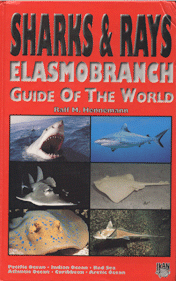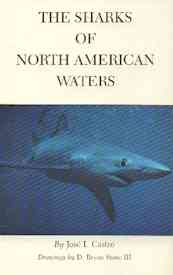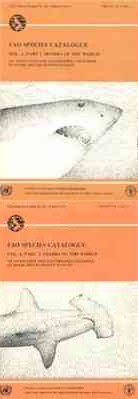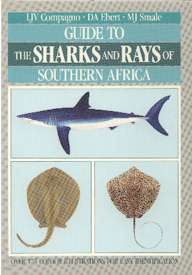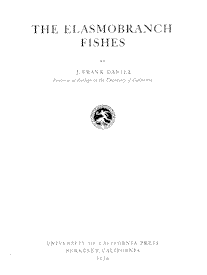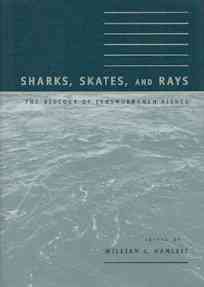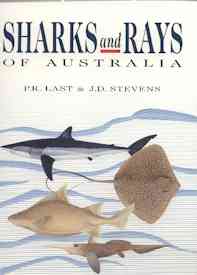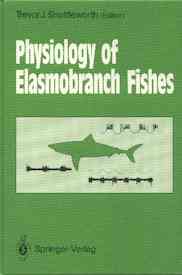Recommended Books for the Advanced Student of Shark Biology
Let's face it: books are an investment in self, but they can easily become an expensive habit. I know this only too well - I typically spend between $15,000 and $18,000 each year on books, both new and used. I'm very fortunate that my wife, Anne, is a 'book-a-holic' too, because if she didn't understand and - wonder of wonders - actually support my addiction, my 42,000-volume personal library would be very much impoverished and I don't believe I could do my job a fraction as well. But for the serious student of shark biology - especially those with a painfully limited budget - it is often impossible to purchase a copy of each and every shark book and not all shark books are equally valuable as references. Below is an annotated list of those 12 titles I consider my most valuable references on the topic of sharks (apart from the primary literature). These are the shark books that I use most often and can heartily recommend to any serious student of shark biology.
|
This book is the result of over a dozen years of effort by many dedicated scientists and conservation biologists, assembling an up-to-date analysis of the status of all the world's cartilaginous fishes. Eight chapters, most consisting of contributions by internationally recognized experts, cover the classification, ecology and life history, socioeconomic importance, and threats faced by chondrichthyans, as well as international conservation initiatives and regional overviews, together with species status reports. Five appendices, a glossary and list of acronyms round out the utility of this book. This is perhaps the single most important contribution, to date, to the chondrichthyan conservation literature. |
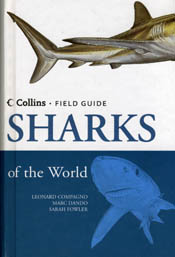 Field Guide to Sharks of the World,
by Leonard Compagno, Marc Dando, and Sarah Fowler.
Collins, London, 2005. 368 pp.
Field Guide to Sharks of the World,
by Leonard Compagno, Marc Dando, and Sarah Fowler.
Collins, London, 2005. 368 pp.A handy global field guide to every known species of living shark. Beautifully illustrated with Marc Dando's meticulous pen-and-ink stipple drawings in the text and gorgeous watercolor paintings in the color plates, which show sharks as living animals and often uses multiple images to illustrate ontogenetic pigmentation changes or color variation in adults. The text includes an excellent introduction to basic shark anatomy, physiology, and life history, with notes on shark utilization, research, and conservation. An illustrated key to shark orders and families aids narrowing down options when keying out a specimen. Each species profiled in the identification section is described in terms of its measurements, identifying features, distribution, habitat, behavior, biology, and IUCN conservation status. Each species range is indicated by a grey-scale map. The text and range maps draw heavily on Compagno's 1984 FAO catalogues, and some errors have been transferred to this new work, but they are so few and minor that they did not detract significantly from the overall quality and reliability of the book. The glossary is quite extensive and good notes on making field observations are included. Suggested further readings, a list of research organizations and websites dedicated to sharks, a bibliography, index of scientific and vernacular names, and a phylogenetic checklist of the world's shark diversity round out the book's use as a reference. |
 Biology of Sharks and Their Relatives,
edited by by Jeffrey C. Carrier, John A, Musick, and Michael
R. Heithaus.
CRC Press, Boca Raton, 2004. 596 pp.
Biology of Sharks and Their Relatives,
edited by by Jeffrey C. Carrier, John A, Musick, and Michael
R. Heithaus.
CRC Press, Boca Raton, 2004. 596 pp.A collection of 19 review papers by a veritable "who's who" of American shark biologists, this volume emphasizes research on sharks and their chondrichthyan kin as living animals. As such, it makes a nice companion volume to Hamlett, ed. (1999) see below which focused more on anatomy and physiology. Among the stand-out chapters here are reviews of the historical zoogeography of sharks, biomechanics of locomotion in chondrichthyans, prey capture mechanics of elasmobranchs, metabolism, energy demand, and endothermy, food consumption and feeding habits, homeostasis, hormonal regulation of elasmobranch physiology, the immune system of elasmobranchs, Life history patterns, demography and population dynamics, Genetics of elasmobranchs, predator-prey interactions, metazoan parasites, and methods of assessing habitat use and movement patterns of elasmobranchs. Although there are some conspicuous "holes" in coverage of the material, this is a terrific volume that is sure to be a standard reference for many years. |
|
This book is a marvel of compactness. It is comprehensive, accurate, up-to-date, and illustrated with hundreds of gorgeous photographs of living chondrichthyans in their natural habitats. Part of IKAN's enormously and deservedly successful series of guidebooks, this volume draws on the publisher's astounding stock of underwater photographs of sharks, rays, and chimaeras including many rare and unusual species never before illustrated in a popular work. The familial taxonomy and phylogenetic sequence of species covered this book is rather dated and/or idiosyncratic, but not enough to invalidate its overall accuracy and usefulness. The font used in the species profiles is rather small and some may find it difficult to read, but there is no question the text crams a great deal of factual information in a very small space. The text draws heavily on Compagno's FAO Catalogue, Sharks of the World (1984), but the author a long-time shark enthusiast and ardent fossil shark tooth collector has also included much information from the primary literature as well as his own experience on research vessels. The species profiles are organized under the following categories: Length, Distribution, Depth, and General. These encyclopedic entries are augmented with photo-illustrated essays from prominent shark researchers and underwater photographers on various aspects of shark biology and behavior. Indices of common and scientific names and a brief bibliography add to the book's utility as a reference. This is an absolute must-have book that belongs in the reference collection of every serious student of chondrichthyan biology, amateur and professional alike. [Top] |
|
Originally released as a special 'double issue' of the Society's journal, Underwater Naturalist (Vol. 19, No. 4 / Vol. 20, No. 1), this collection of articles honors the work of pioneer shark biologist Stewart Springer. It consists of 24 semi-popular articles by many of today's foremost chondrichthyan researchers and covers many of the most interesting and active areas of shark biology, including evolution, diversity, physiology, sensory biology, feeding, reproduction, behavior, shark attacks, and fisheries management. The volume works very well as an up-date and extension of Sanford Moss' Sharks: an Introduction for the Amateur Naturalist as well as a stand-alone reference. Each article concludes with a listing of "Additional Readings" which serves as a nice pointer to important recent articles in the primary literature. The work is illustrated throughout with clear black-and-white photos as well as informative diagrams, tables, and charts. The endpapers include accurate line drawings of representative cartilaginous fishes and the last page features shark-themed "Far Side" cartoons by Gary Larson. [Top] |
|
This book is both a handy field guide to the 115 or so sharks of the region and a concise introduction to shark anatomy. Written by one of the premier shark biologists working today and illustrated by the very talented D. Bryan Stone III, this book features detailed, authoritative text covering: Description, Similar Species, Range, Biology, Reproduction, Relation to Man, Fishing, and References, supported by very good to excellent black-and-white drawings of shark anatomical features, as well as lateral views, underside of the head, and teeth of each species covered. Includes dichotomous keys as an aid to identification. The first edition includes inserts of some beautiful color photographs. As this is a book that will be used a great deal, I strongly recommend trying to locate the hard-cover edition, which hold up better to the physical stresses of laboratory and field. Hardcover Out-of-Print [Top] |
|
Although a new edition is currently being prepared, this is still the 'bible' for shark identification. Written by the leading architect of modern chondrichthyan systematics, this is an encyclopedic work of staggering comprehensiveness and utility. Each species profile features Synonymy, FAO Names, Field Marks, Diagnostic Features, Geographical Distribution, Habitat and Biology, Size, Interest to Fisheries, Local Names, Literature, and Remarks. The text features illustrated dichotomous keys at the familial, generic and species level as aids to identification. An appendix includes detailed information on preserving sharks for scientific study. Each species is illustrated with a range map, black-and-white drawing of a lateral view, underside of the head, and teeth; the drawings vary enormously in quality, from poor to excellent. The Index lists not only current scientific names but also synonyms, making this work useful for putting a modern scientific name to out-dated names used in older sources. Out-of-Print [Top] |
|
Although the text is not as detailed as the terrific (but, alas, out-of-print) series of ORI reports by Bass et al., this is a compact, handy field guide to the rich (175+ species) chondrichthyan fauna of the region with concise, accurate text by three first-rank shark biologists and illustrated with the very good watercolor paintings of Ann Hecht. Each species description features Identification, Size, Range, Habitat, Biology, and Human Impact. The text also features a concise summary of basic shark biology. [Top] |
|
(Sorry, no Dust Jacket on my copy) Despite its age, is by far the best introduction to elasmobranch anatomy yet published. Richly detailed text and abundant, high-quality anatomical illustrations are of a caliber rarely achieved nowadays. With a heavy emphasis on Notorynchus cepedianus, the author describes: External Form, Integument, Endoskeleton, Musculature, Digestive Tract, Respiratory Tract, Circulatory System, Nervous System, Nervous System, Special Senses, and Urogenital System. Some beginning students may find the level of detail a bit overwhelming at first; to them, I would recommend starting with A Photographic Atlas of Shark Anatomy by Carl Gans and Thomas S. Parsons (Academic Press, New York. 1964). But for the serious student of elasmobranch morphology, systematics, or paleontology, Daniel's classic work can't be beaten. The first edition of this classic text appeared in 1922 and was revised and expanded for the second edition in 1928; this review refers to the third edition - but any edition you can lay hands on will be well worth your while. Out-of-Print [Top] |
|
This is a spectacularly comprehensive summary of elasmobranch anatomy and physiology, richly illustrated with hundreds of black-and-white photos and diagrams. Each chapter is written by one or more acknowledged experts in the topic discussed and features an extensive list of References. The 16 chapters are: Systematics and Body Form; Integumentary System and Teeth; Endoskeleton, Muscular System: Gross Anatomy and Functional Morphology of Muscles; Muscular System: Microscopical Anatomy, Physiology, and Biochemistry; Digestive System; Respiratory System; Circulatory System: Anatomy of the Peripheral Circulatory System; Circulatory System: Distinctive Attributes of the Circulation of Elasmobranch Fish; Heart; Nervous System; Special Senses; Rectal Gland and Volume Homeostasis; Urinary System; Female Reproductive System; and Male Reproductive System. The Appendix, Checklist of Living Elasmobranchs, by Compagno, is also most useful. The index is excellent. This is an indispensable work, sure to be the standard reference for many years to come. [Top] |
|
Intended to be used as a field guide, this is a big, impressive, extremely solid book that is the first to survey the region's rich chondrichthyan fauna (at least 296 species) in over 50 years. Collectively, the authors are Australia's foremost authorities on this regions cartilaginous fishes and they have done a stellar job summarizing each species via the following categories: Field Characters, Distinctive Features, Color, Size, Distribution, Remarks, Local Synonymy, and Remarks. Each species is illustrated with a range map, black-and-white lateral view, underside of the head, and teeth; exquisite full-color paintings by the very talented Roger Swainston add greatly to the book's appeal and usefulness. Illustrated dichotomous keys are an aid to identification. There is an excellent list of References and an Index of common and scientific names. My chief complaint with this volume is the large number of un-named species, listed by genera as "species A, B, C ... " sometimes all the way to "species P". Despite the book's size and heft (about 2 kilos), this is a very useful reference, describing between its covers almost a third of our planet's cartilaginous fishes. Out-of-Print [Top] |
|
This book is a marvel of compactness, featuring concise, detailed text on the Identification, Size, Range, Reproduction, and Biology of the nearly 170 elasmobranch species covered, most of which are illustrated with at least one gorgeous, full-color photo and the remainder with a good black-and-white drawing. Perhaps the best part of the book, however, is the author's introductory material, surveying elasmobranch Food Habits, Interspecific Interactions, Reproductive Behavior, Development of the Young, Eggcase Types, Social Behavior, Segregation, Social Units, and Diver-Shark Interaction. A fine list of References provides a helpful guidepost to much important primary literature on many of the species covered. Also includes an Appendix on courtship and mating in four species of elasmobranch, illustrated with the author's full-color photos. There is an Index, but its not as detailed as I'd like. Overall, this is a very compact, useful field guide and reference. [Top] |
|
Originally written as an undergraduate textbook, this book is a wonderful bridge between popular shark books and the primary literature on elasmobranch fishes. The author, a bona fide shark biologist, does a particularly fine job explaining the scientific foundation behind what is known of the evolution, structure, and kinematics of shark feeding mechanisms, the physiology of shark sensory systems, shark hydrodynamics, reproduction, and osmoregulation; his coverage of shark brain morphology, behavior, metabolism and symbionts is less complete but still useful. With full citations to the most important relevant literature at the conclusion of each chapter and an excellent index, this book is perhaps the most painless way to graduate from dilettante shark nut to serious student of shark biology. Out-of-Print [Top] |
|
A remarkably compact, authoritative survey of elasmobranch physiology, illustrated with hundreds of graphs, tables, and black-and-white photographs. Each chapter is written by an acknowledged expert on the relevant elasmobranch system. Topics covered: Cardiovascular and Respiratory System, Central Nervous System, Sensory Physiology, Muscles and Locomotion, Autonomic Nervous System, Salt and Water Balance - External Mechanisms, Kidney Function, Acid-Base Regulation, Nitrogen Metabolism, and Reproductive Physiology. Each chapter lists extensive references and there is an excellent index. Oddly, there is no coverage of the elasmobranch digestive tract. Despite this obvious shortcoming - and the book's hefty pricetag (typical of this publisher, which I jokingly refer to as "Springer-Wallet"), this is an excellent and very useful reference on elasmobranch physiology. Out-of-Print [Top] |
|
Written as a handy question-and-answer book for interested laypersons, this is a terrific source for even serious students of shark biology needing quick answers to basic questions and a useful guidepost to the relevant primary literature. The questions are grouped by subject area and logically sequenced. The text is clear and concise, illustrated with hundreds of black-and-white photos and diagrams. Three useful appendices are included: an annotated Classification of Shark (listing all 368 species known at the time), Selected List of Common and Scientific Names of Sharks, and Lengths of Selected Sharks. A good Glossary, Bibliography and References, and Index round out the book, adding significantly to its utility as a very worthwhile reference. There is also an insert of color photos but, in the soft-cover edition, the spine has a disconcerting tendency to split, causing all these pages to fall out. For this reason, and the heavy use this book is likely to receive, I strongly recommend the hard-cover edition. This book also made my list of Top 10 All-Time Favorite Shark Books. [Top] |
| To Purchase
Any of These Books:
Please contact your local, Independent Bookseller about Special Ordering the book(s) you want. Independent Booksellers are the life's blood that keeps publishers and authors in business; they need and deserve your support. Otherwise, try: Natural History Book Services, Amazon.com, or Barnes and Noble |
|
To Purchase Out-of-Print Books: Many of these books are out of print and some have been for many years. To locate a copy for your personal library, try: www.abebooks.com, www.addall.com, or www.bibliofind.com |
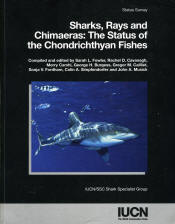 Sharks,
Rays and Chimaeras: the Status of the Chondrichthyan Fishes
Sharks,
Rays and Chimaeras: the Status of the Chondrichthyan Fishes